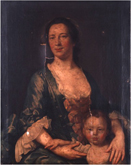'Portrait of Mrs Bradford (nee Anne Larkin) and Samuel Bradford', 1752, oil on canvas
Artist unknown. Private collection.
Description
The painting is a double portrait of Mrs Anne Bradford and her son, Samuel Bradford, painted in London, in around 1752, by an unknown British portrait painter. It is owned by a Melbourne family who are the descendants of the sitters. The portrait arrived in Australia in 1859.
Condition
When the painting arrived at CCMC, it was in a degraded condition, owing to the two large tears. There was dirt across the surface, and a degraded, darkened natural resin varnish covering the painting.
Treatment
The painting was cleaned and the discoloured varnish removed. The old patches on the reverse were removed. The tears were repaired using a thread-by-thread mending technique (see image below).
A conservation-grade varnish was applied, and the losses filled and inpainted to match the original surrounding paint layer. A final spray-coating of varnish was applied.
Treatment stages
Figure 1
Before treatment (cleaning test evident on sleeve of Mrs Bradford)
Figure 2
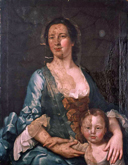
During treatment, partial removal of discloured varnish
Figure 3

During treatment, after complete removal of varnish, prior to inpainting tears and damages
Figure 4
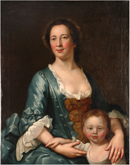
After treatment
Figure 5
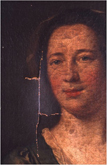
Before treatment, detail of tear and discoloured varnish
Figure 6
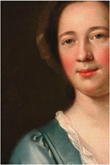
During treatment, after varnish removal, before inpainting of tear
Figure 7
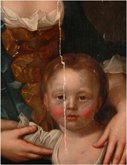
During treatment, after varnish removal, before inpainting of tear
Figure 8

After treatment, detail, after inpainting
Figure 9
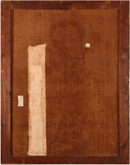
Before treatment, reverse of the canvas with old patches present
Figure 10
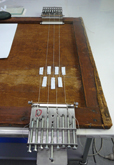
"Trekker" instrument, used to draw the torn canvas together to enable repair of the tear
Figure 11

After treatment, detail of the tear repair on the reverse, with sutures of polyester applied with a synthetic adhesive to provide additional support
Figure 12
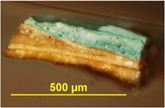
Analytical methods are used to investigate the artist’s technique and to inform the treatment approach. Tiny samples of paint are removed and mounted in resin to reveal a cross-section of the paint layers. This sample is taken from the dress, and reveals the typical English double ground layer and then the pigmented paint layers on top
